Похожие презентации:
Telecommunications and Networks
1.
Telecommunicationsand Networks
McGraw-Hill/Irwin
Copyright © 2009 by The McGraw-Hill Companies, Inc. All rights reserved.
2. Network Concepts
• A network is an interconnected orinterrelated chain, group, or system
6-2
3. Telecommunication Trends
6-34. Telecommunications-Based Services
6-45. Internet Networking Technologies
• Internet networking technologies are beingused as technology platform
– Web browser suites
– HTML Web page editors
– Network management software
– Firewalls
• Being applied in Internet, intranet, and
extranet applications
• Reinforces previous move toward client/server
networks based on open-systems architecture
6-5
6. Open Systems
• Open systems use common standardsfor hardware, software, applications, and
networks
– Internet networking technologies are a
common standard for open systems
• Connectivity
– Open systems provide greater connectivity
and network interoperability
– Middleware may be needed to help diverse
systems work together
6-6
7. Middleware
• Middleware– A general term for any programming that
mediates between two separate programs
– Allows a particular database to access other
databases without custom programming
• Commonly known as the “plumbing” of an
information system
– It routes data and information between backend data sources and end user applications
– An essential component of any IT infrastructure
6-7
8. Wireless Technologies
• Fiber-optic– Uses pulses of laser-generated light
– Reduced size and installation effort
– Vastly greater communication capacity
– Faster transmission speeds
– Freedom from electrical interference
• Satellite Transmission
– Can move massive quantities of data, audio,
and video over global networks
– Especially useful in isolated areas
6-8
9. Business Application Trends
• Telecommunications networks nowplay a vital and pervasive role in
Web-enabled…
– E-business processes
– Electronic commerce
– Enterprise collaboration
– Other applications that support
operations, management, and strategic
objectives
6-9
10. Internet2
• Next generation of the Internet– High-performance
– Different infrastructure than the current Internet
– Infinite bandwidth
6-10
11. Value of Telecommunications Networks
6-1112. Internet Service Providers
• ISP– A company that specializes in providing easy
access to the Internet
– For a monthly fee, provides software, user
name, password, and Internet access
• ISPs themselves are connected to one
another through network access points
– One ISP can easily connect to another to
obtain addresses of websites or user nodes
6-12
13. Business Use of the Internet
6-1314. Business Value of the Internet
6-1415. The Role of Intranets
• Many companies have sophisticated andwidespread intranets, offering…
– Detailed data retrieval
– Collaboration
– Personalized customer profiles
– Links to the Internet
• Intranets use Internet technologies
– Web browsers and servers
– TCP/IP network protocols
– HTML publishing and databases
6-15
16. Intranets
• Intranets are protected by…– Passwords
– Encryption
– Firewalls
• Customers, suppliers, and other
business partners can access an
intranet via extranet links
6-16
17. Business Value of Intranets
• Intranets support– Communications and collaboration
– Business operations and management
– Web publishing
– Intranet portal management
6-17
18. Intranets as Information Portals
6-1819. Extranets
• Network links that use Internettechnologies to connect the intranet of a
business to the intranets of another
• Virtual Private Networks
– Direct private network links, or private secure
Internet links between companies
• Unsecured Extranet
– Link between a company and others via the
Internet, relying on encryption of sensitive
data and firewall security systems
6-19
20. Extranet Connectivity
6-2021. Business Value of Extranets
• Web browser technology makes customerand supplier access to intranets easier and
faster
• Another way to build and strengthen
strategic relationships
• Enables and improves collaboration
between a business, customers, and
partners
• Facilitates online, interactive product
development and marketing
6-21
22. Telecommunications Network Model
• A telecommunications network isany arrangement where
– A sender transmits a message
– To a receiver
– Over a channel
– Consisting of some sort of medium
6-22
23. Telecommunications Network Model
6-2324. Telecommunications Network Components
• Terminals– Any input/output device that uses networks
to transmit or receive data
• Telecommunications processors
– Devices that support data transmission, reception
• Telecommunications channels
– Media over which data are transmitted, received
• Computers
– All sizes and types
6-24
25. Telecommunications Network Components
• Telecommunications control software– Controls telecommunications activities
– Manages the functions of telecommunications
networks
• Includes network management programs of
all kinds
– Telecommunications monitors (mainframes)
– Network operating systems (network servers)
– Web browsers (microcomputers)
6-25
26. Network Component Alternatives
6-2627. Types of Communications Networks
• Primary types of communicationsnetworks
– Wide Area
– Local Area
– Virtual Private
– Client/Server
– Peer-to-peer
6-27
28. Local Area Network (LAN)
• Connects computers within a limited physicalarea, such as an office, classroom, or building
6-28
29. Virtual Private Networks (VPN)
• Used to establish secure intranets andextranets
– The Internet is the main backbone network
– Relies on network firewalls, encryption, and
other security features to build a “pipe”
through the Internet
– Creates a private network without the high
cost of a separate proprietary connection
6-29
30. Virtual Private Network
6-3031. Client/Server Networks
• Clients– End user personal computers or networked
computers
• Servers
– Used to manage the networks
• Processing
– Shared between the clients and servers
– Sometimes called a two-tier architecture
• Larger computer systems are being
replaced
with multiple client/server networks
6-31
32. Client/Server Network
6-3233. Peer-to-Peer Networks
• Central Server Architecture– P2P file-sharing software connects all PCs
to a central server
– When a PC requests a file, the server
searches
all active peers on the network
– The server sends the requesting PC a list of
links to all active peers who have the file
– Clicking a link connects the two PCs and
automatically transfers the file to the
requesting PC
6-33
34. Peer-to-Peer Networks
• Pure Peer-to-Peer Architecture– No central directory or server
– File-sharing software connects one PC to
another online user
– When you request a file, the software
searches every online user and sends you a
list of active file names
– Clicking a link automatically transfers the file
from that user’s hard drive to yours
6-34
35. Peer-to-Peer Network Diagrams
6-3536. Wireless Technologies
• Wireless LANS– Uses wireless radio-wave technology to
connect PCs within an office or a building
– Can be high-frequency, similar to digital
cellular, or low frequency (spread spectrum)
• Bluetooth
– Short-range wireless technology
– Connects PCs to devices, such as a printer
– Fairly low cost to implement
6-36
37. Wireless Technologies
• Other Wireless Systems– Cellular phones
– Mobile radio
– PDAs
• Telecommunications networks now play vital and
pervasive roles in
– Web-enabled e-business processes
– Electronic commerce
– Enterprise collaboration
– Other applications that support business operations,
management, and strategic objectives
6-37
38. The Wireless Web
• Wireless Internet access is growing as Webenabled information appliances proliferate– Smart telephones, pagers, PDAs
– All are very thin clients in wireless networks
6-38
39. Telecommunications Processors
• Modems– The most common type of
communications processor
– Converts a digital signal to an analog
frequency that can be transmitted over
phone lines, then back into a digital
signal
• Modulation and demodulation
6-39
40. Comparing Technologies
6-4041. Inter-Network Processors
• Switch… makes connections betweentelecommunications circuits in a network
• Router… intelligent communications
processor that interconnects networks
based on different protocols
• Hub… a port-switching communications
processor
• Gateway… connects networks with
different communications architectures
6-41
42. Communications Processors
6-4243. Communications Processors
• Multiplexer… allows a singlecommunications channel to carry
simultaneous data transmissions from
many terminals
– In time division multiplexing (TDM), the
multiplexer divides the time each terminal can
use the high-speed into short time slots
• Multiplexers increase the number of
transmissions possible
– Does not increase the number of physical data
channels
6-43
44. Telecommunications Software
• May reside in PCs, servers, mainframes,and communications processors
– Vital part of all telecommunications networks
– Used to manage network performance
– WANs often use telecommunications
monitors or teleprocessing monitors
– Other networks use operating system
software
– Middleware helps diverse networks
communicate with each other
6-44
45. Network Management Functions
• Traffic Management– Manage network resources and traffic to
avoid congestion and optimize service levels
• Security
– Provide authentication, encryption, firewall,
auditing, and enforcement
• Network Monitoring
– Troubleshoot and watch over the network,
alerting administrators of potential problems
6-45
46. Network Management Functions
• Capacity Planning– Survey network resources, traffic
patterns, and users’ needs
– Determine the best way to
accommodate the needs of the
network as it grows and changes
6-46
47. Network Topologies
• Topology– The structure of a network
• Star Network
– Ties end user computers to a central computer
• Ring Network
– Ties local computer processors together in a
ring on a relatively equal basis
• Bus Network
– Local processors share the same
communications channel
6-47
48. Network Topologies
• Mesh Network– Uses direct communications lines to connect
some or all of the computers in the ring to
each other
• Switch
– A message-switching computer that handles
data communication between autonomous
local computers
6-48
49. Network Topologies
6-4950. Network Architectures and Protocols
• Protocol– A standard set of rules and procedures for
the control of communications in a network
• Handshaking
– The process of exchanging predetermined
signals and characters
– Establishes a telecommunications session
between terminals and computers
6-50
51. Network Architectures and Protocols
• Network Architecture– Master plan of standard protocols,
hardware, software, and interfaces
between end users
and computer systems
– Goal is to promote an open, simple,
flexible,
and efficient telecommunications
environment
6-51
52. OSI and TCP/IP Models
• Open Systems Interconnection (OSI)Model
– A seven-layer model that serves as a standard
model for network architectures
– Model for how messages should be
transmitted between two points in a network
– Each layer adds functions
• Transmission Control Protocol/Internet
Protocol (TCP/IP)
– A five-layer telecommunications protocol used
by the Internet
6-52
53. OSI and TCP/IP Models
6-5354. Voice Over IP
• Internet Telephony– Using an Internet connection to pass voice
data using IP instead of a telephone network
– Often referred to as voice over IP or VoIP
– Works like a regular phone, but skips longdistance charges
– Runs over standard network infrastructure
– Requires a well-configured network to work
smoothly
6-54
55. Bandwidth
• Bandwidth– The frequency range of a telecommunications
channel that determines the maximum
transmission rate
– Speed and capacity typically measured in bits
per second (bps)
– Sometimes call baud rate
• Transmission Rates
– Narrow-band = low speed
– Broadband = high speed
6-55


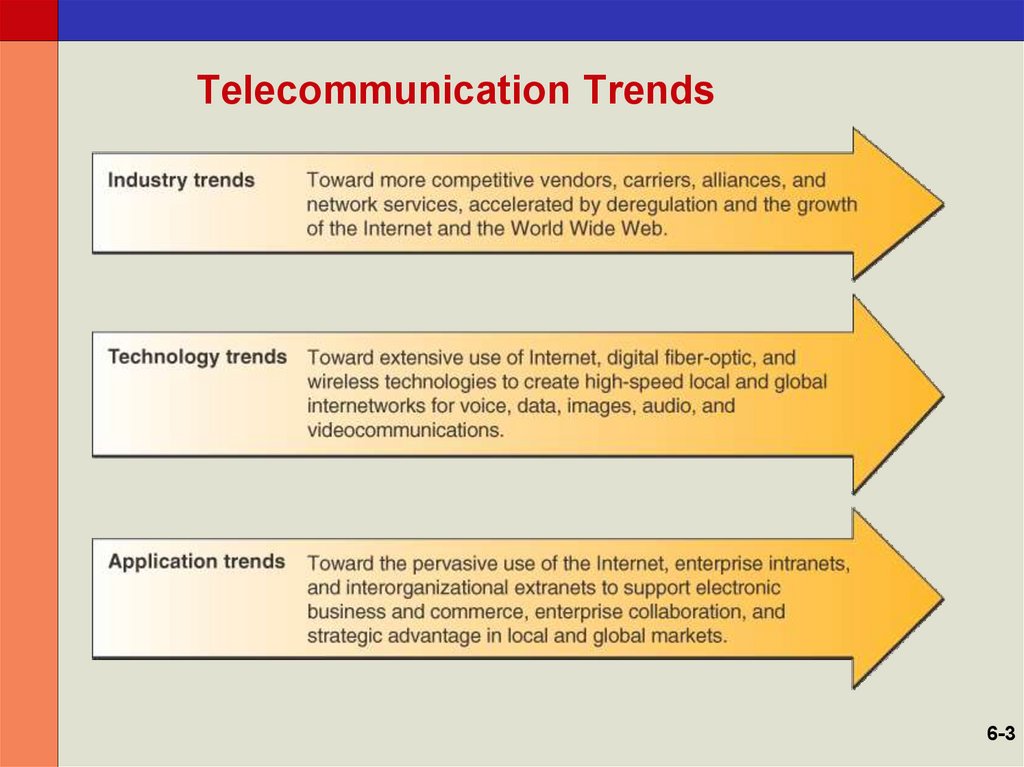



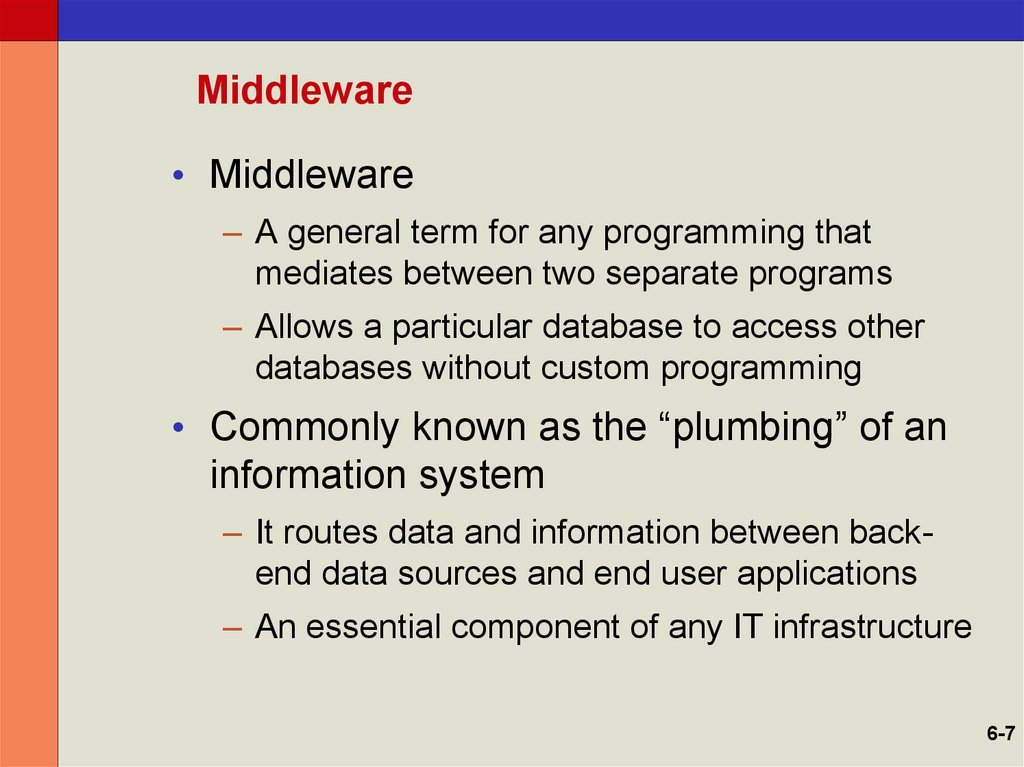
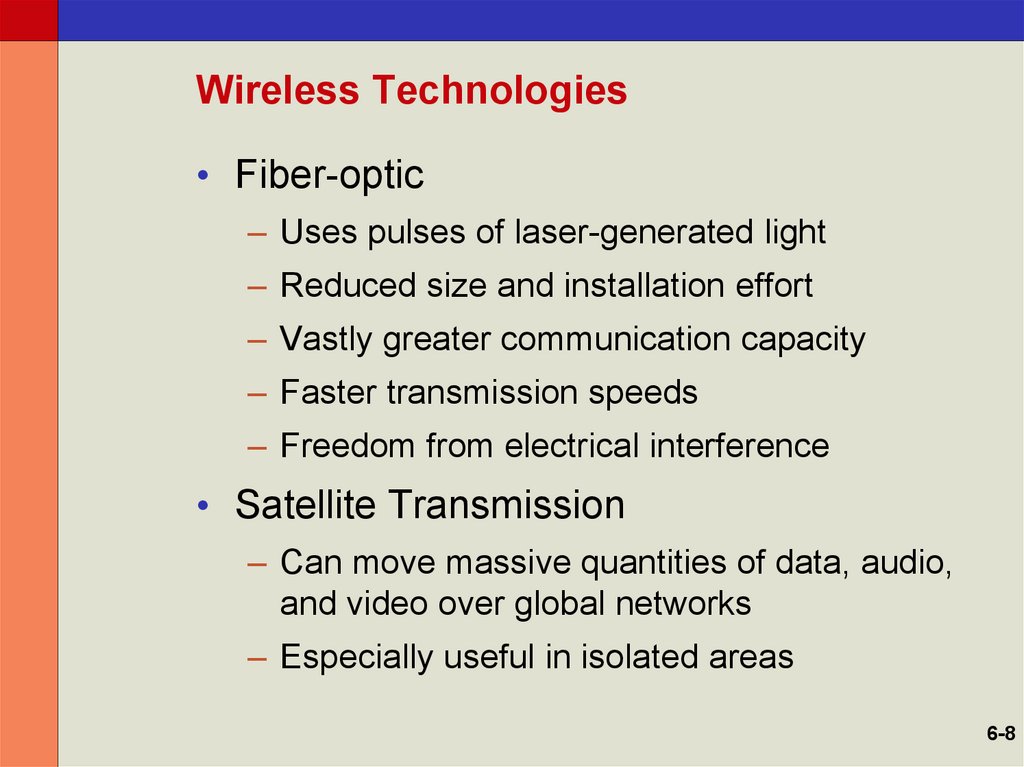
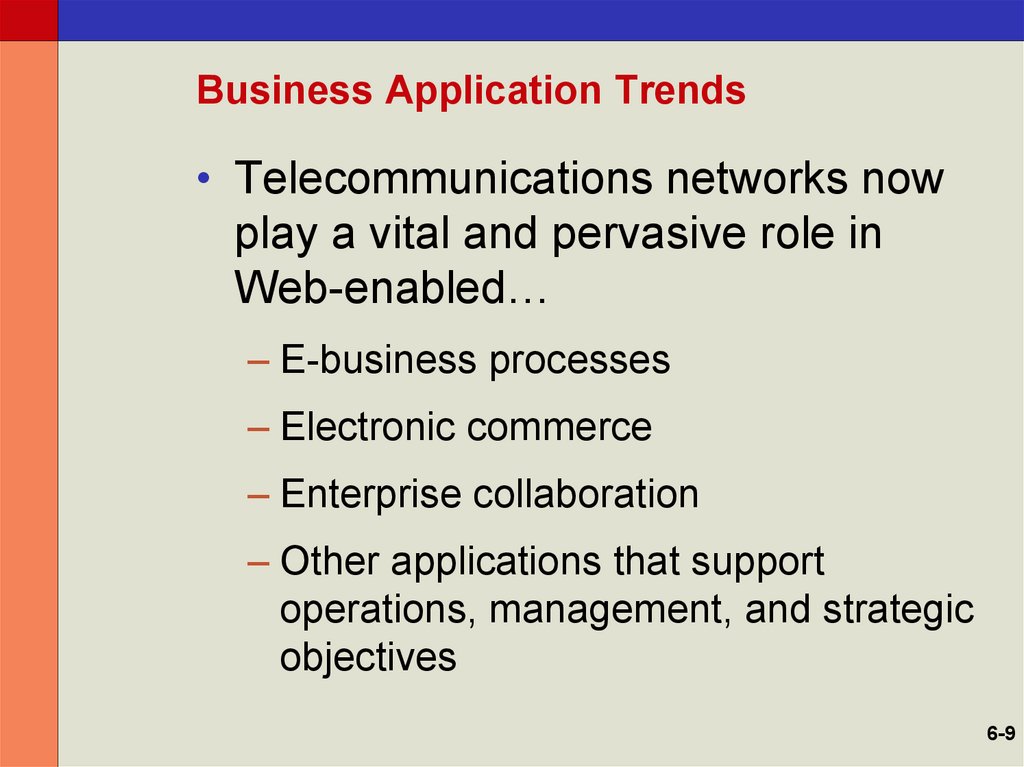
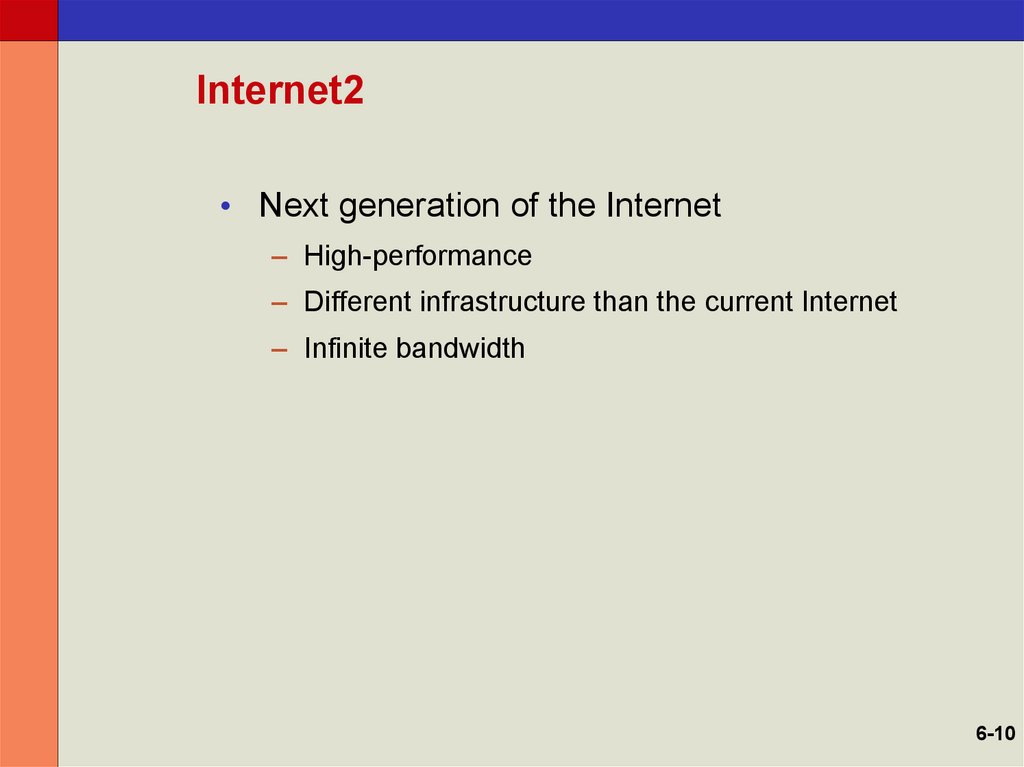
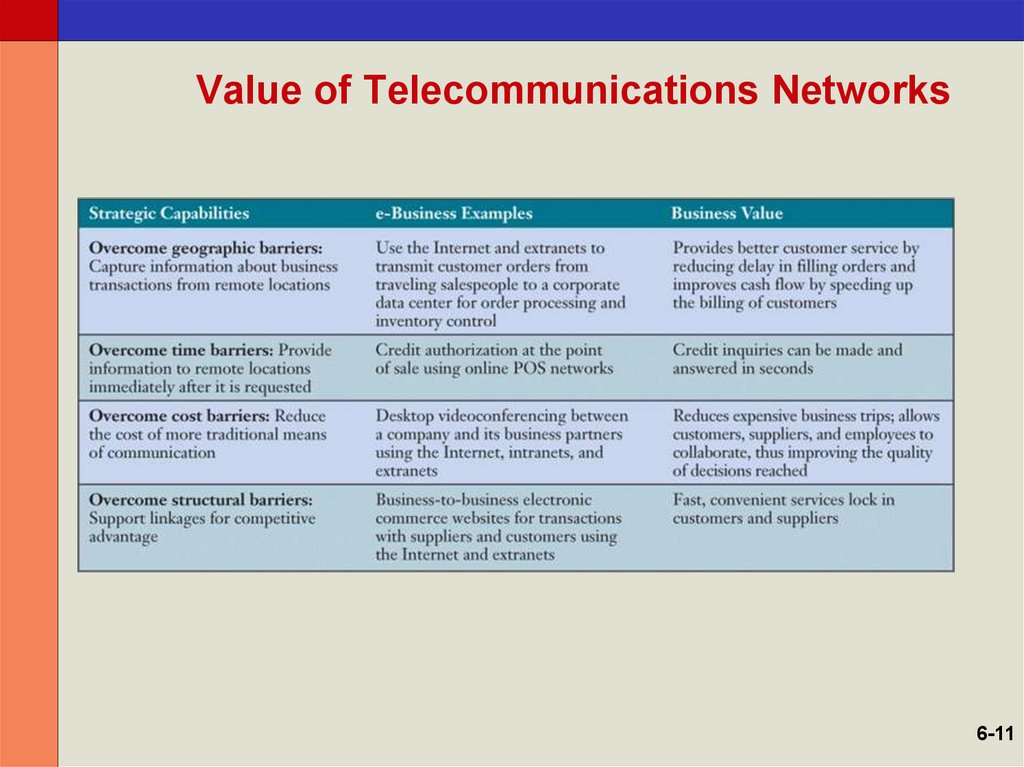
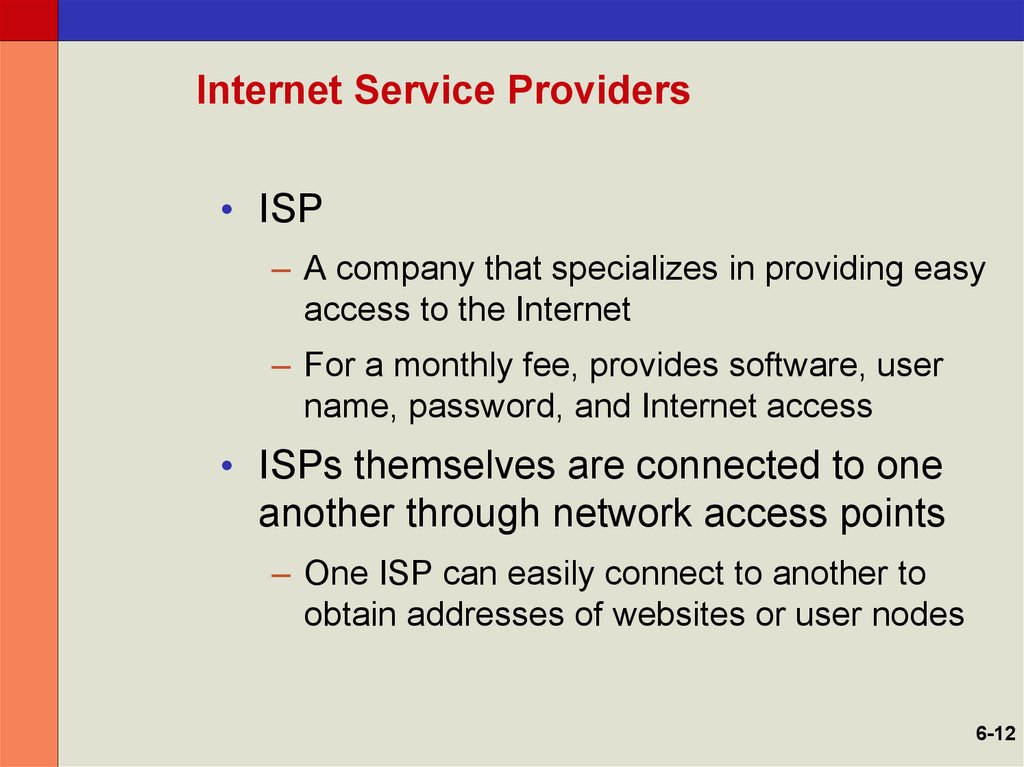



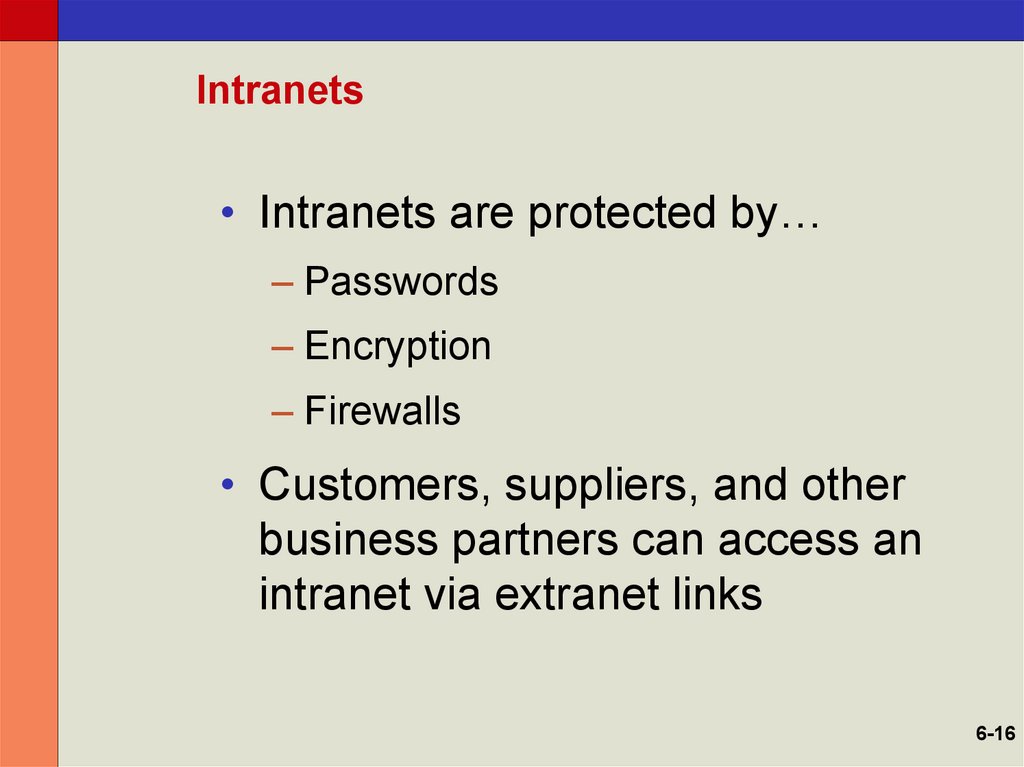
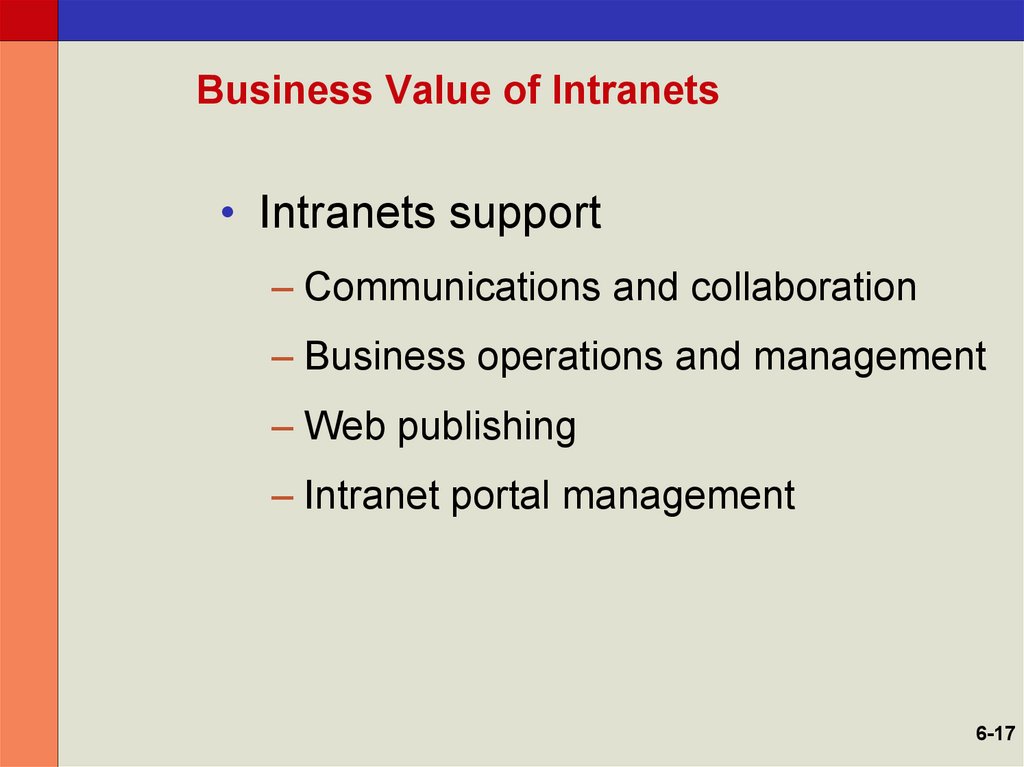

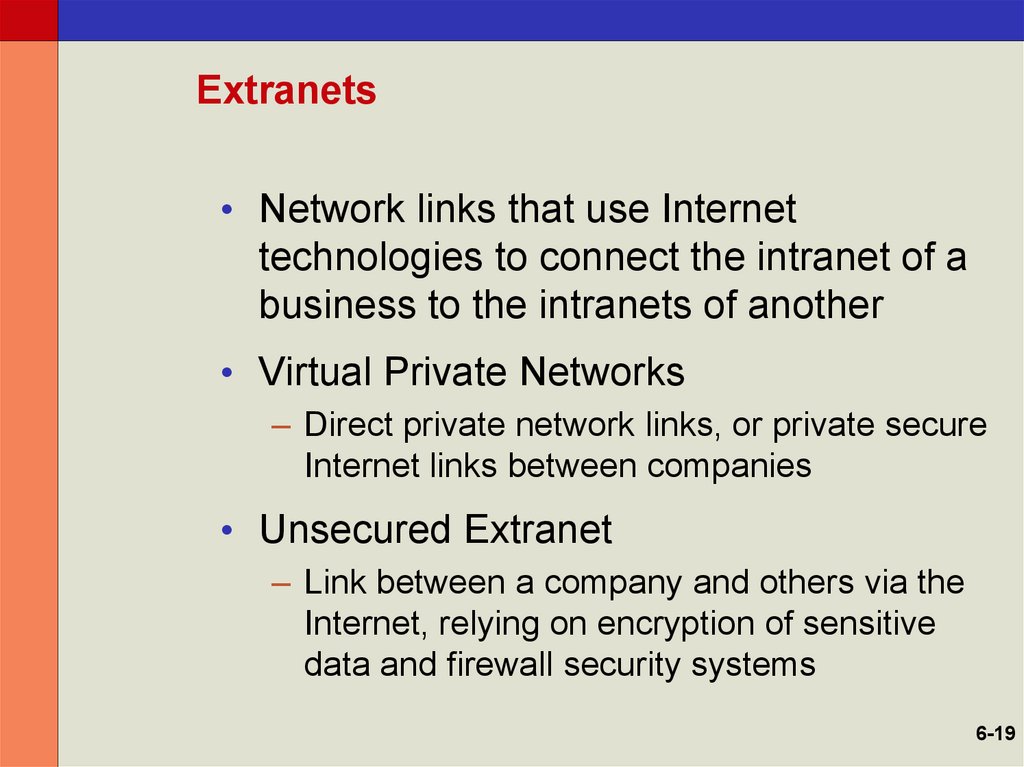


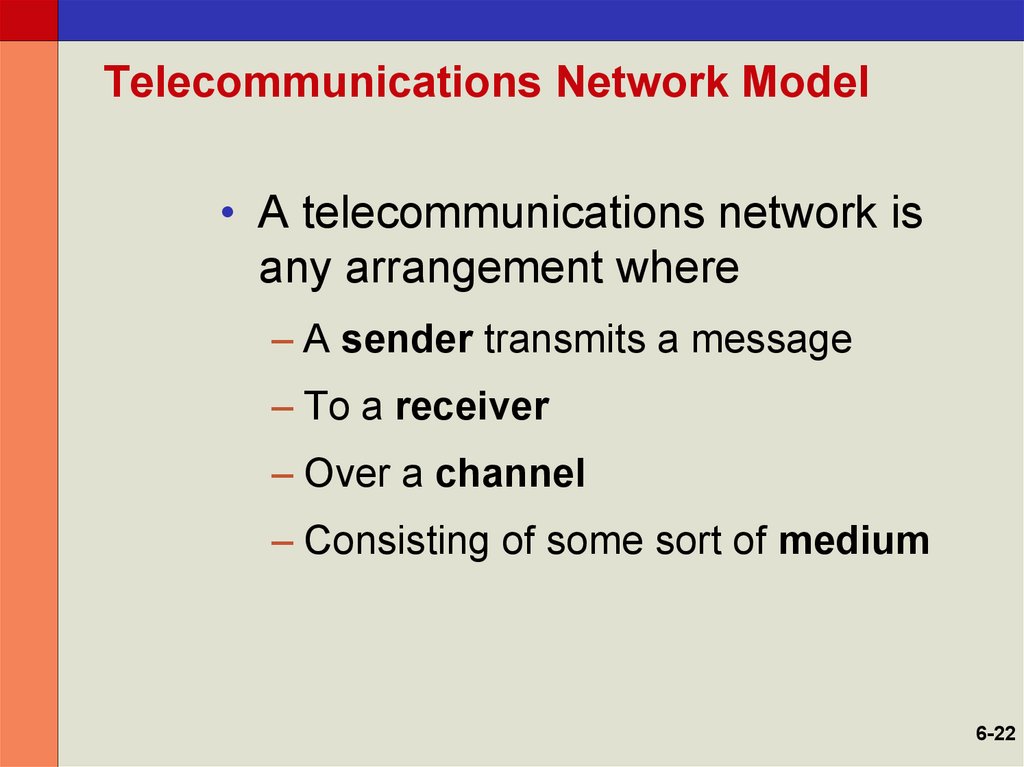

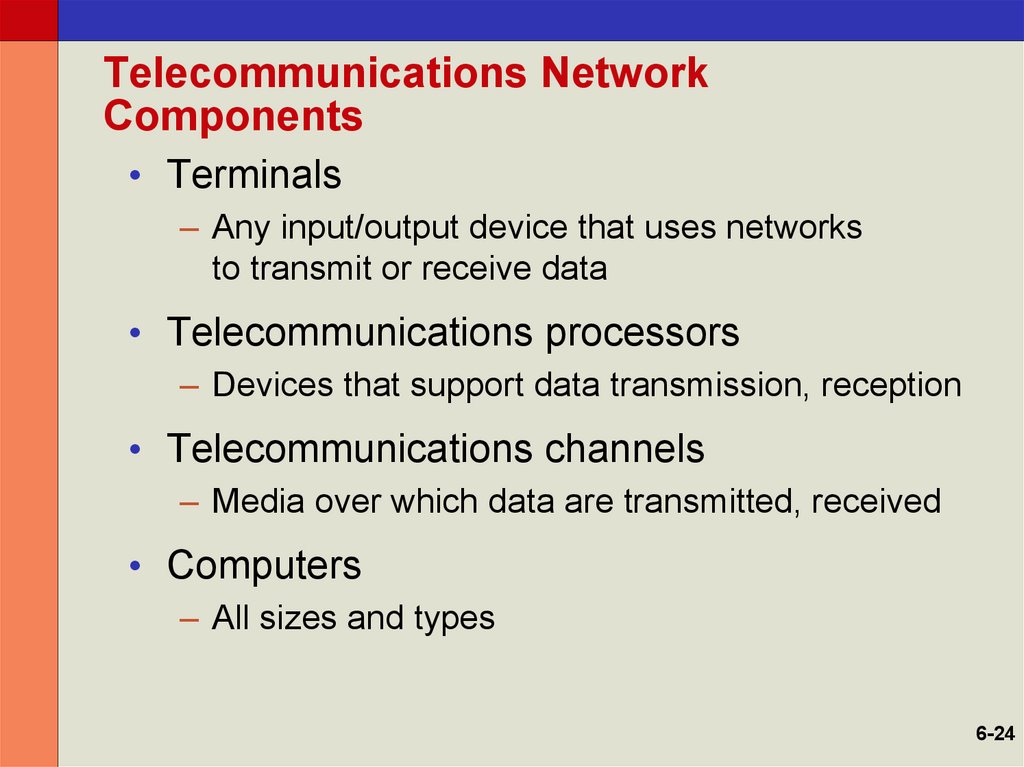
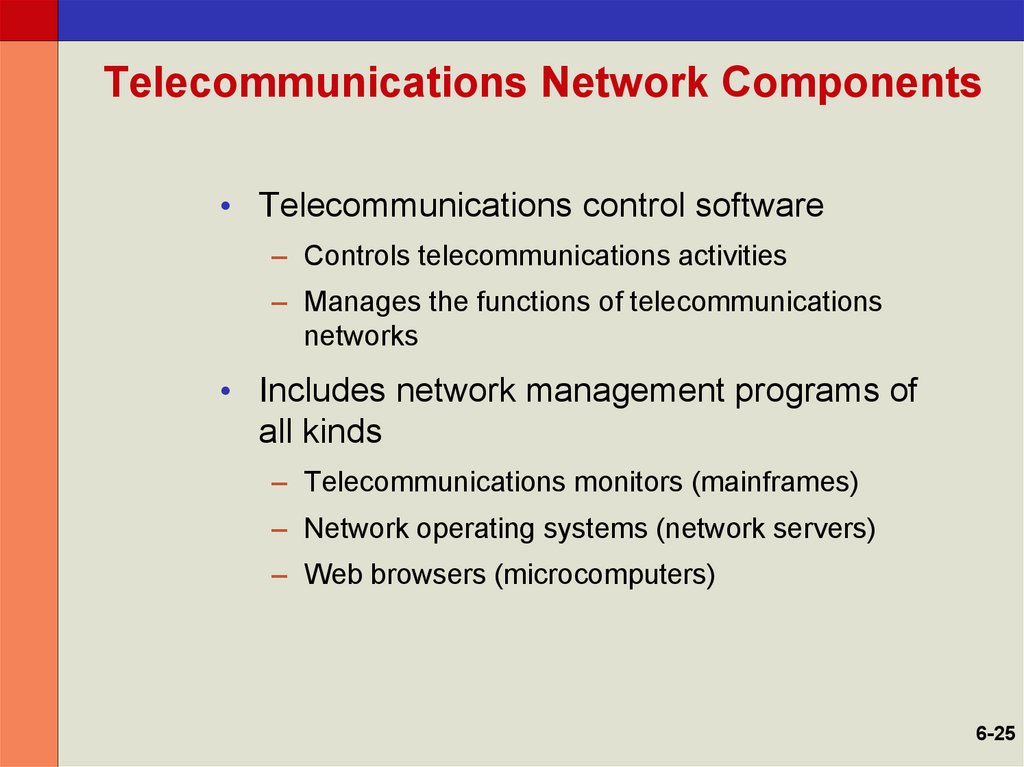
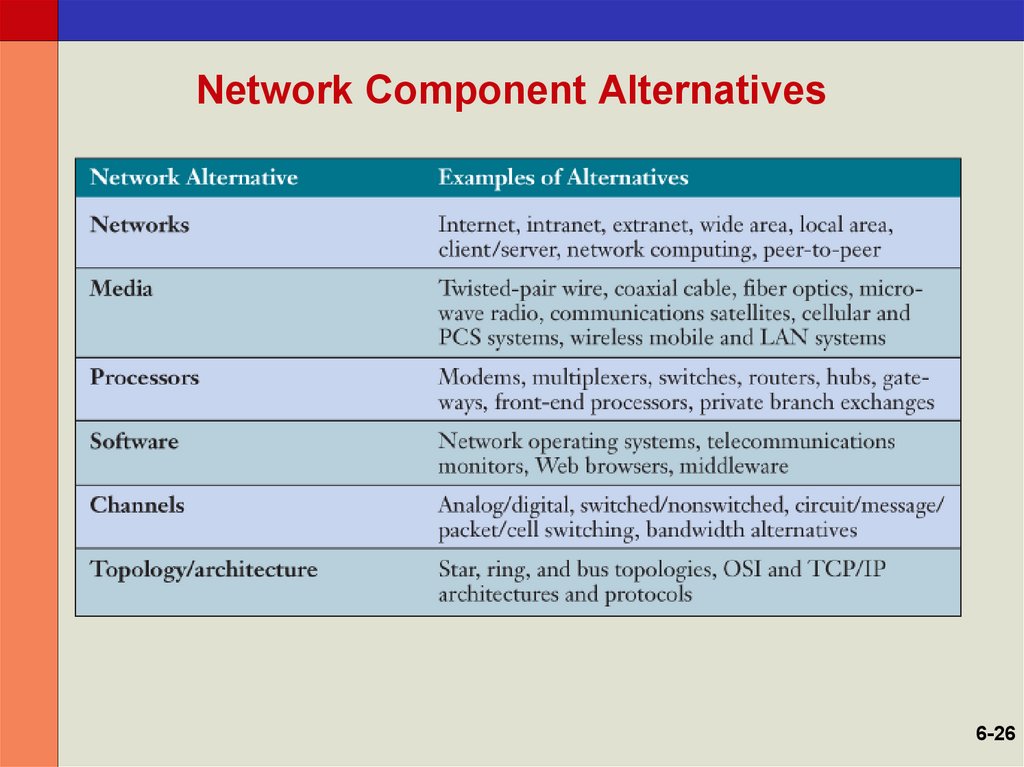
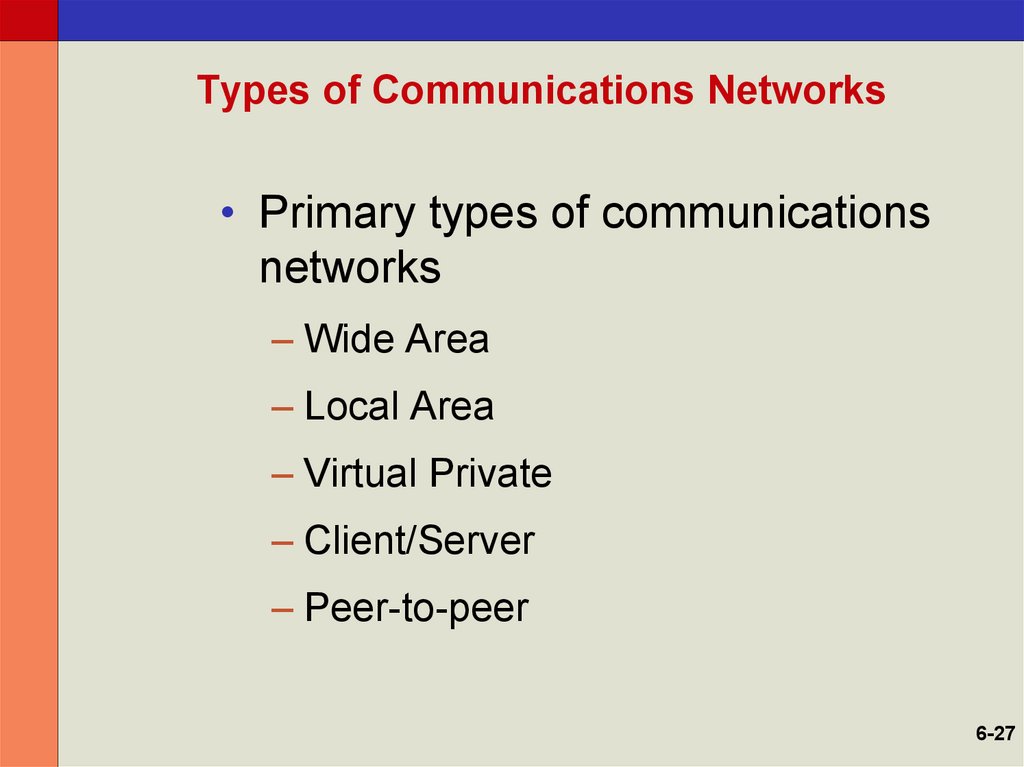

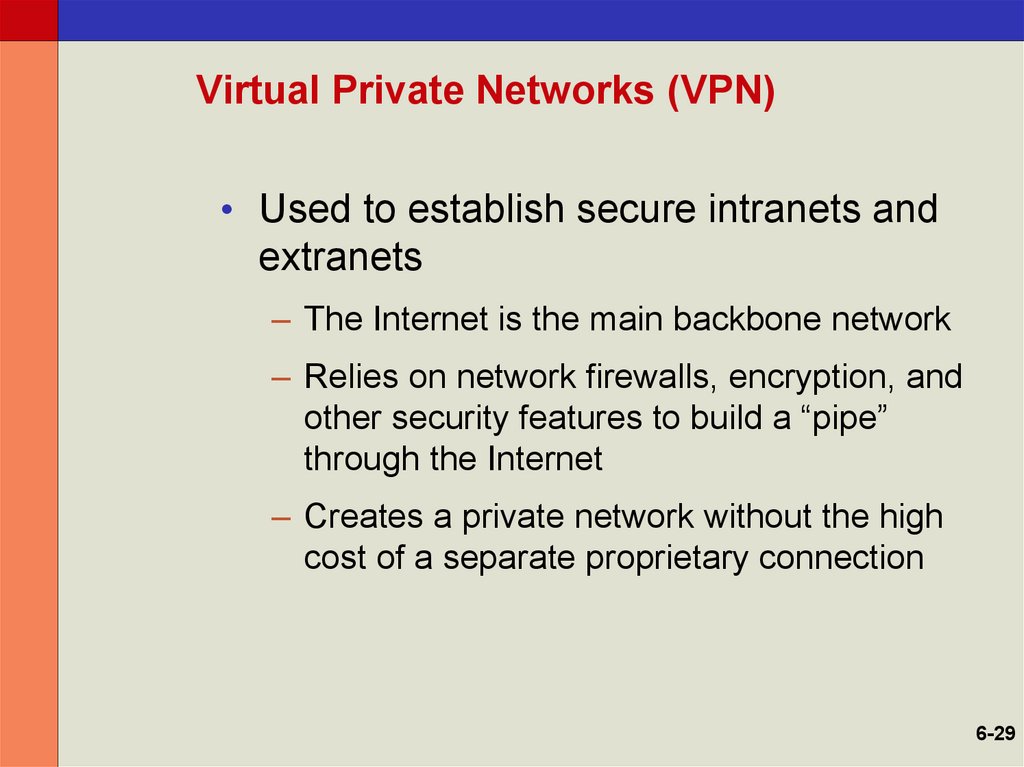
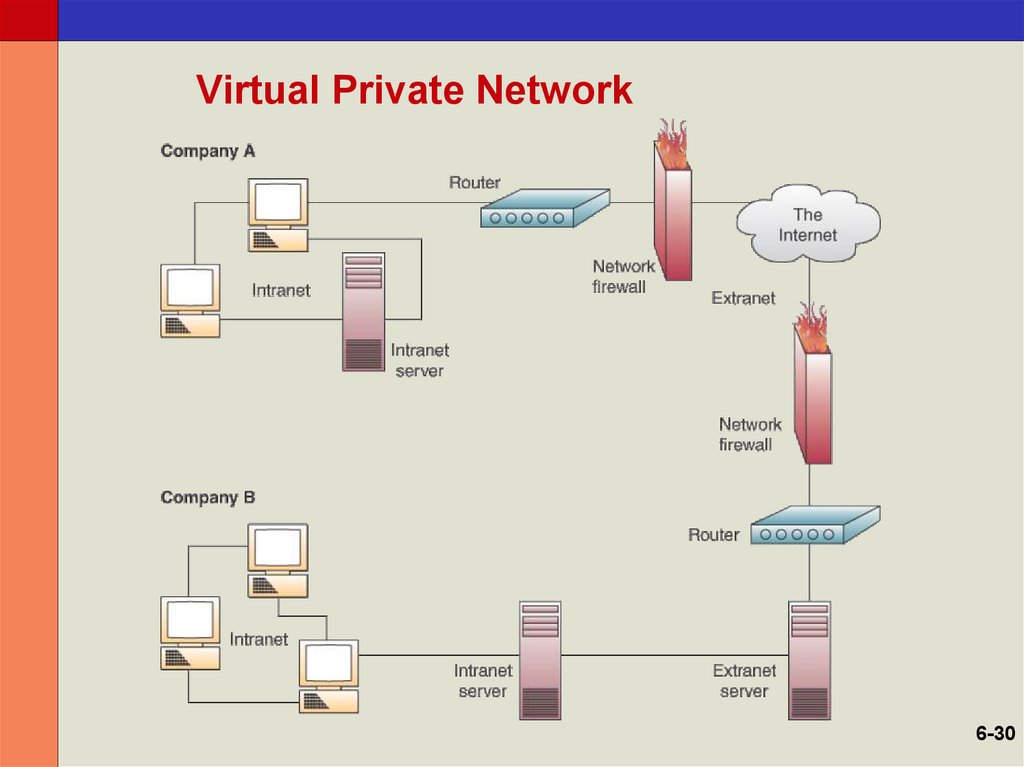
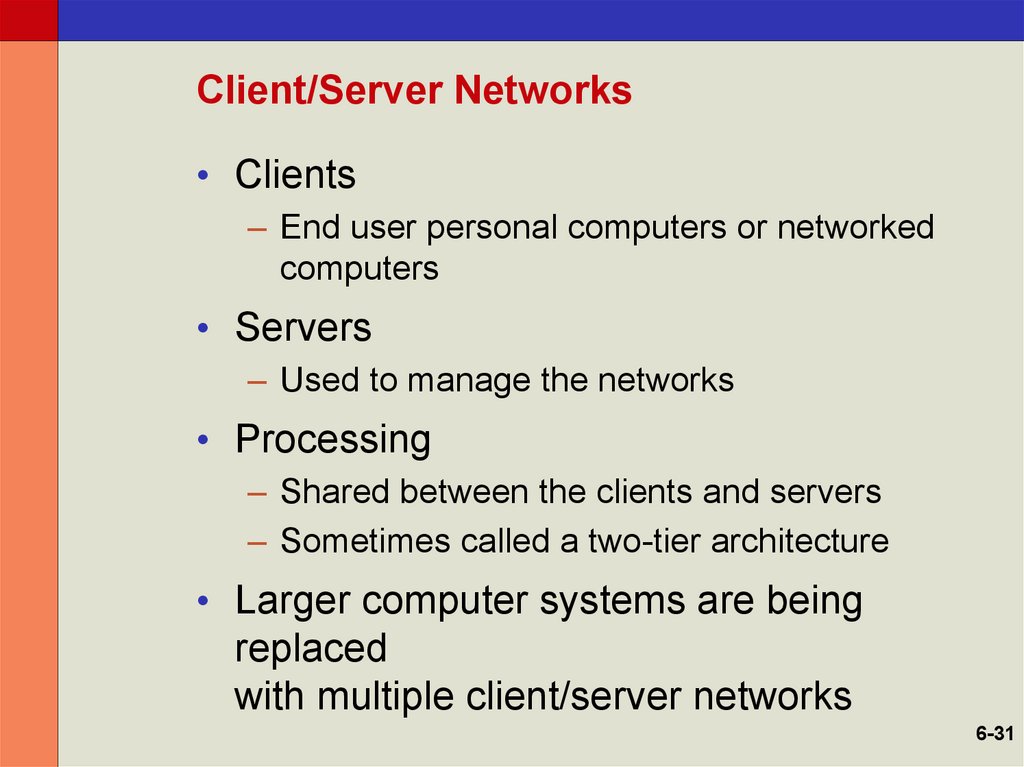

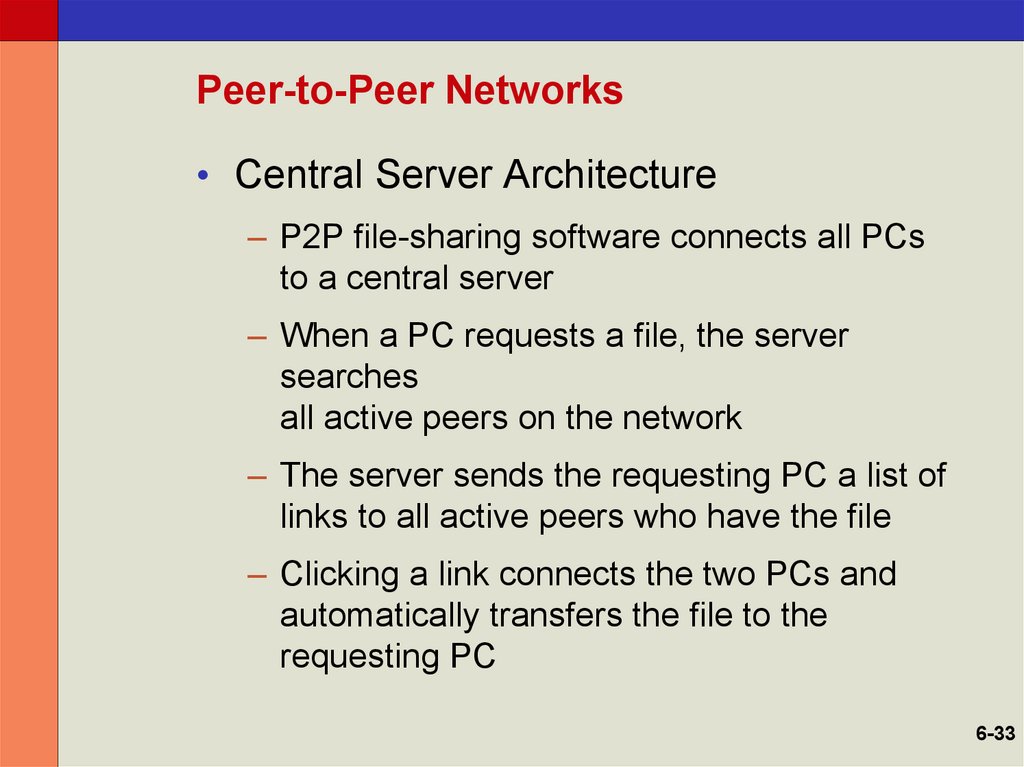
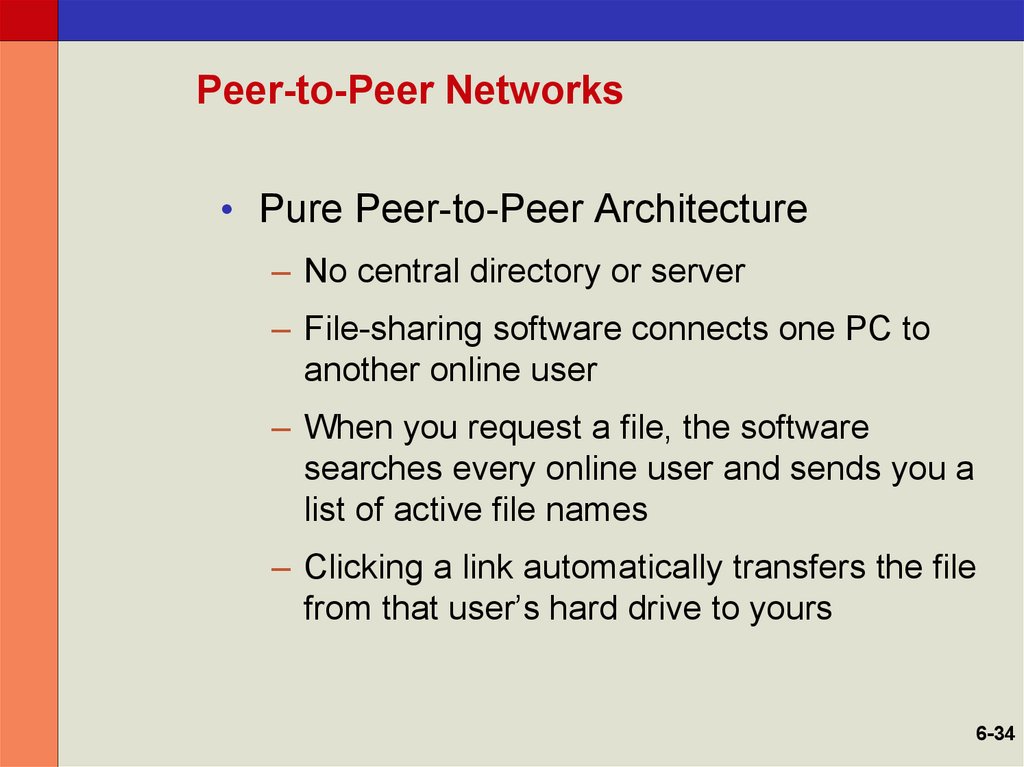

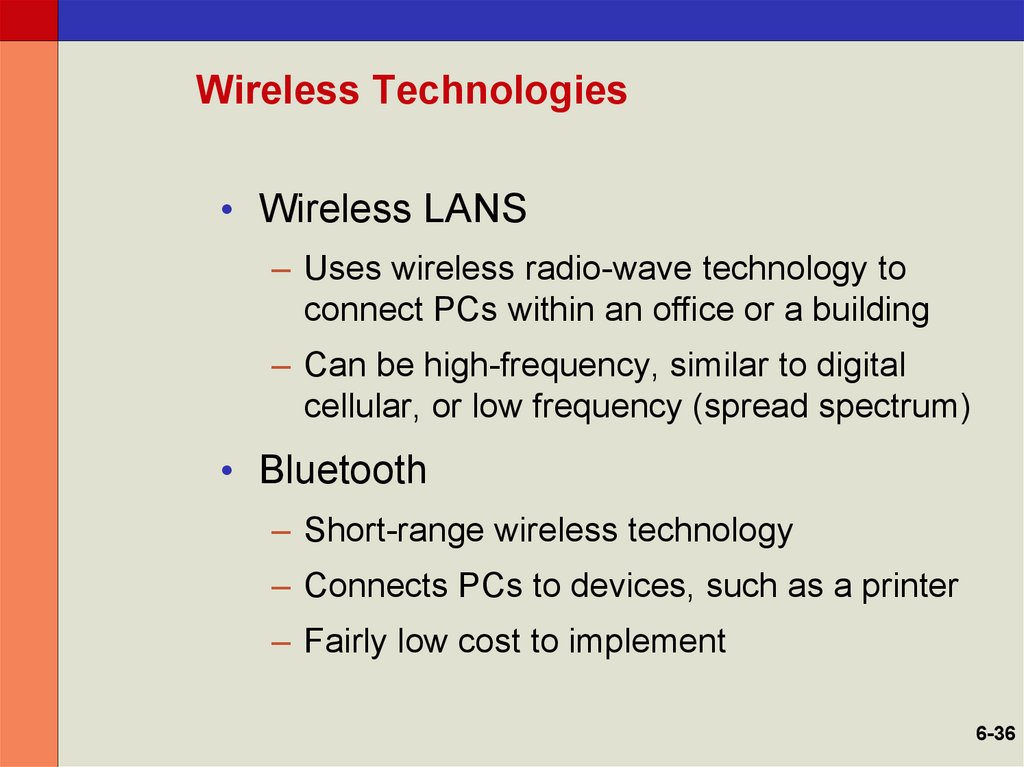
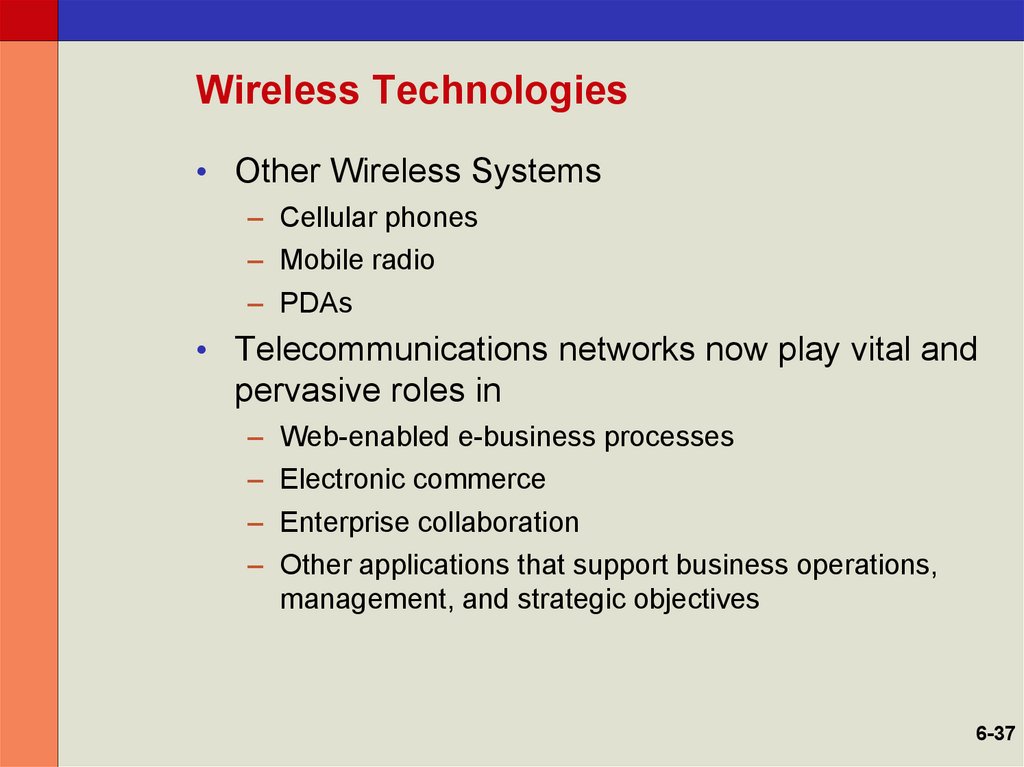
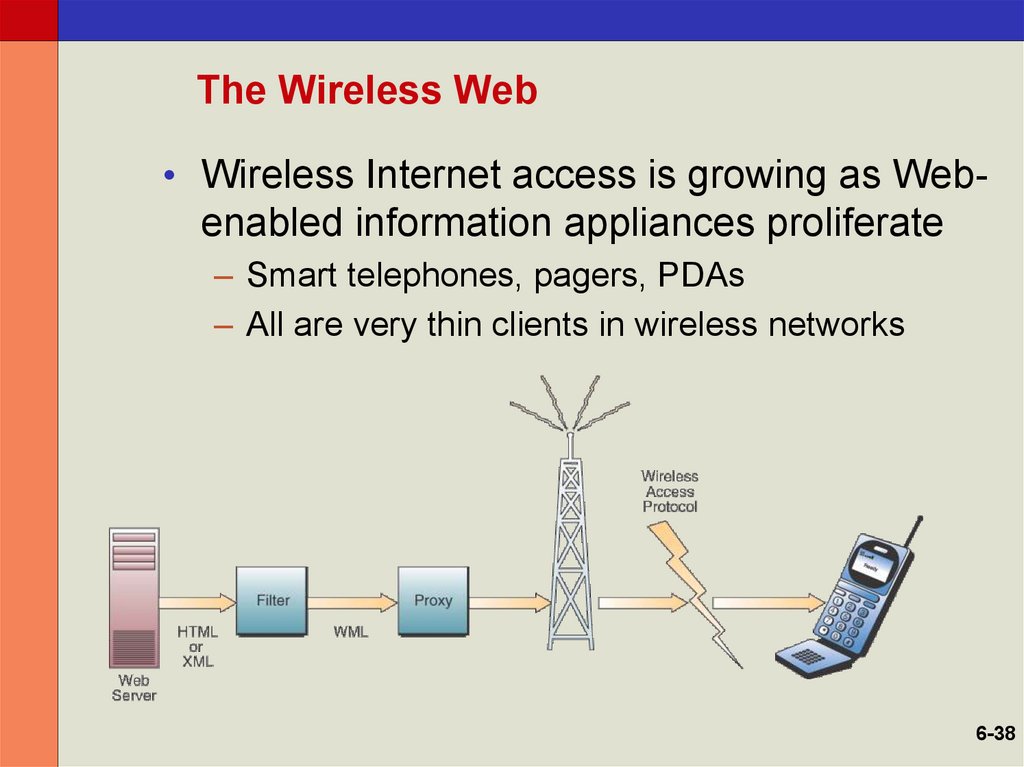
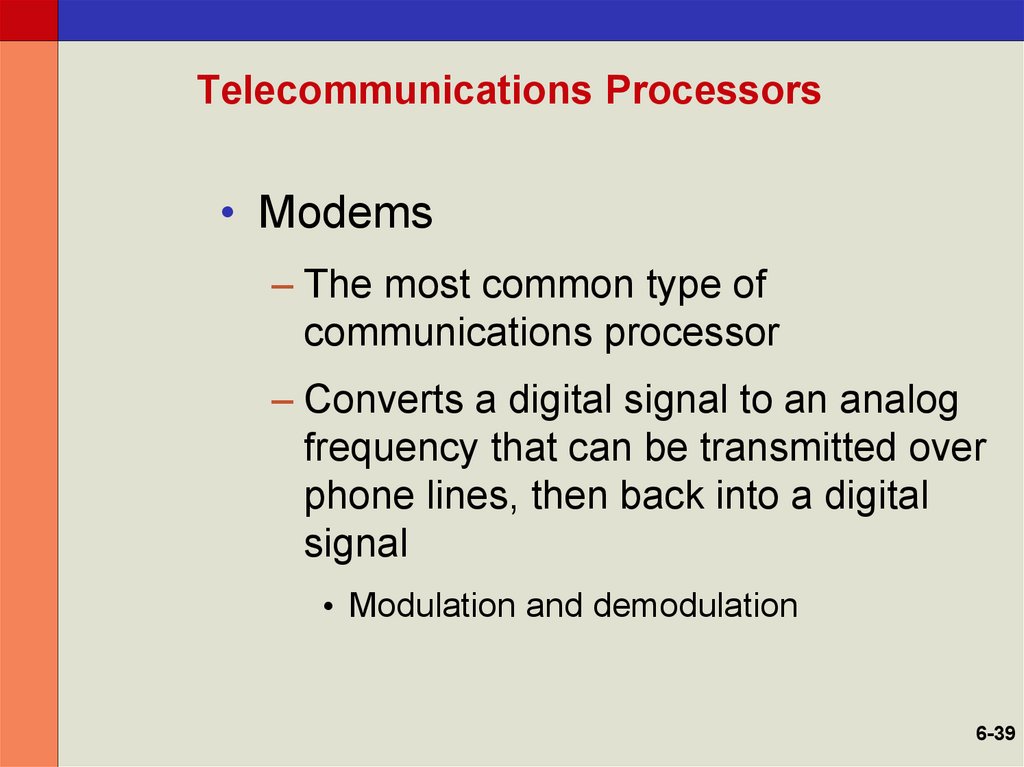
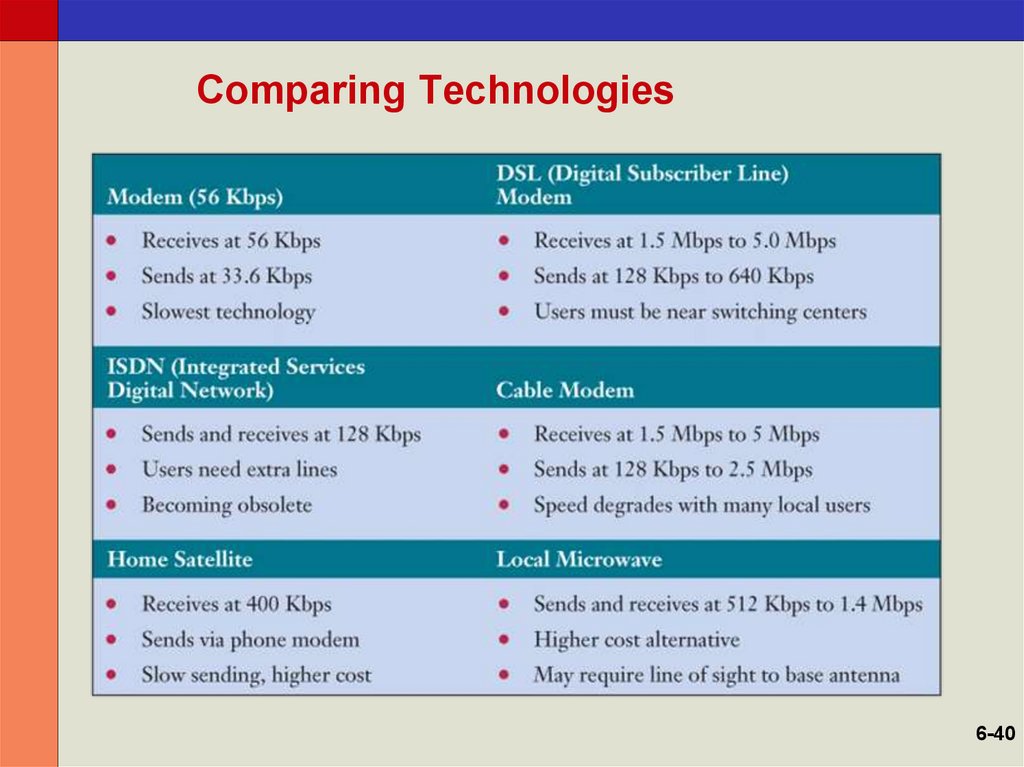
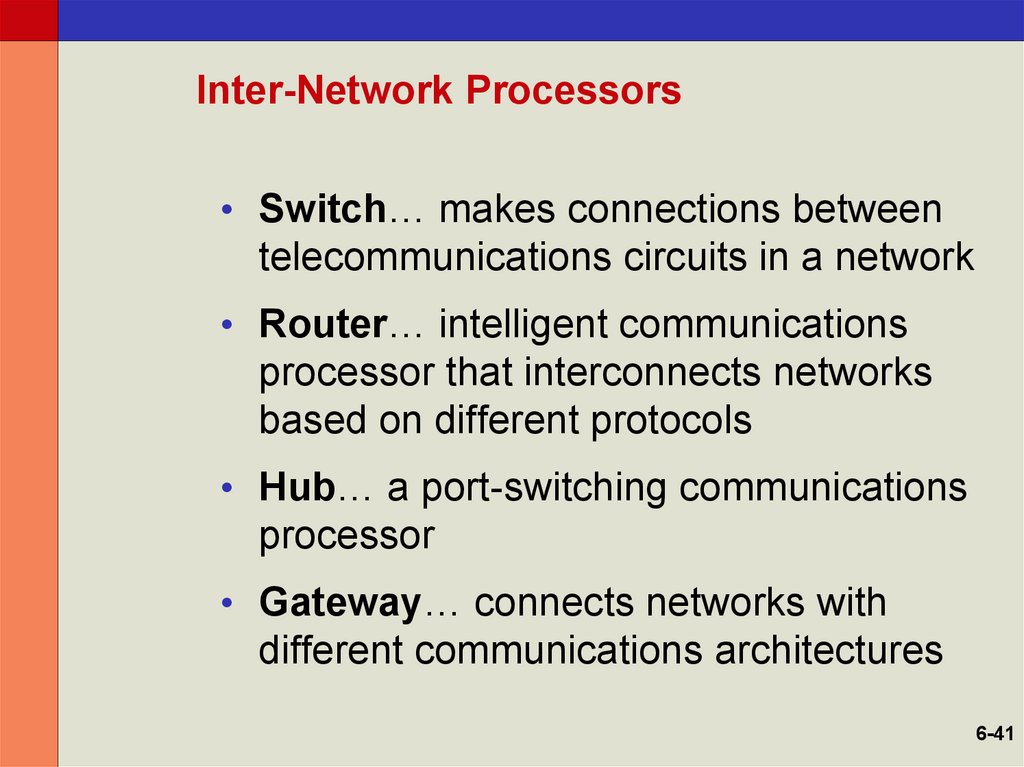
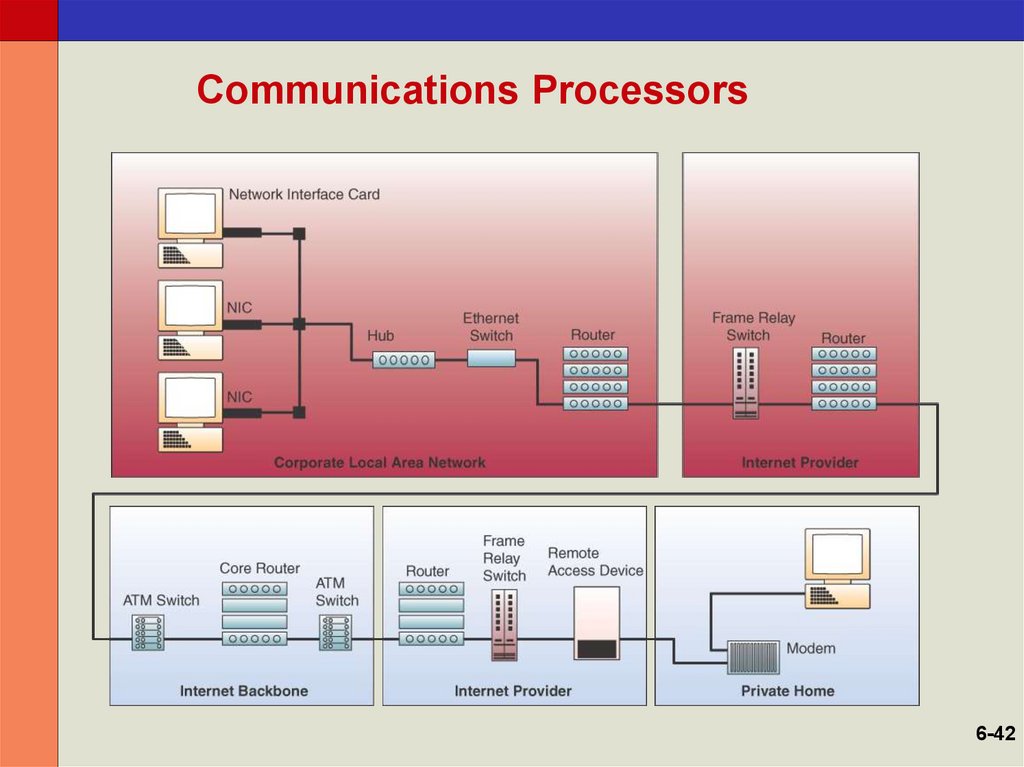


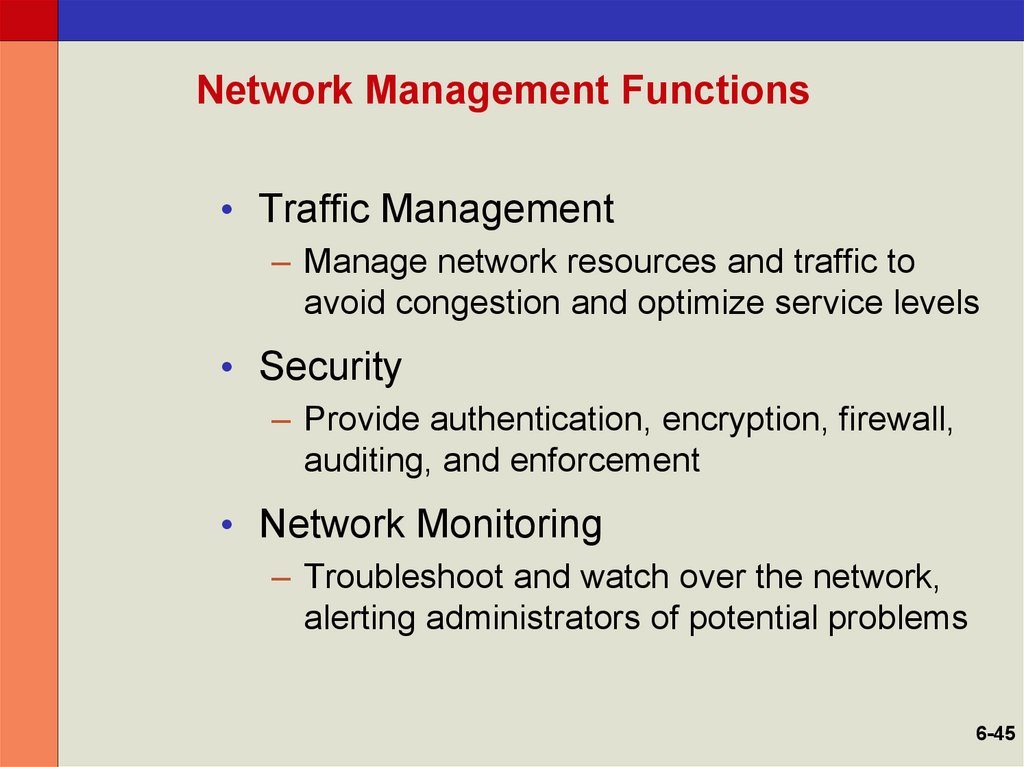

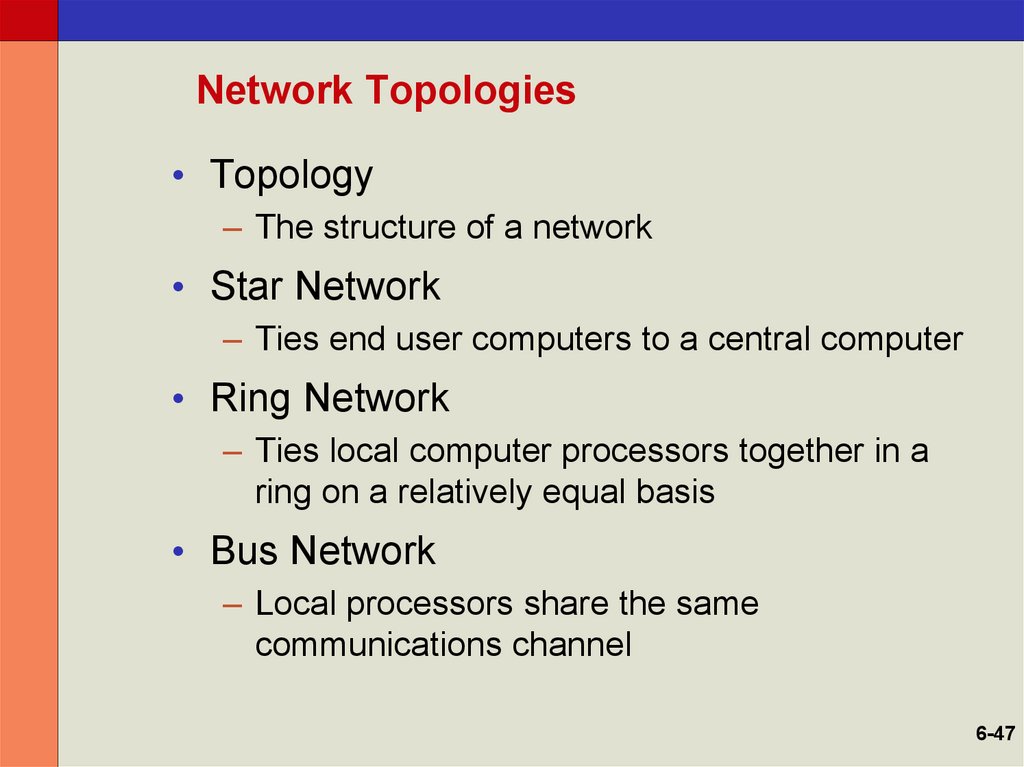

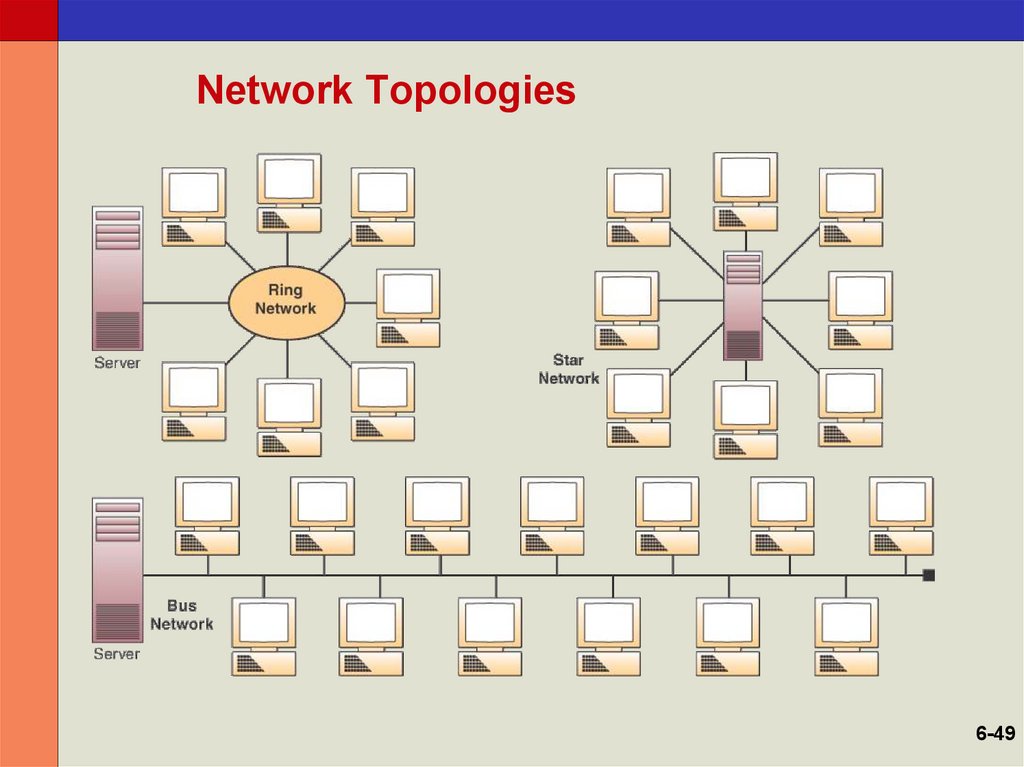

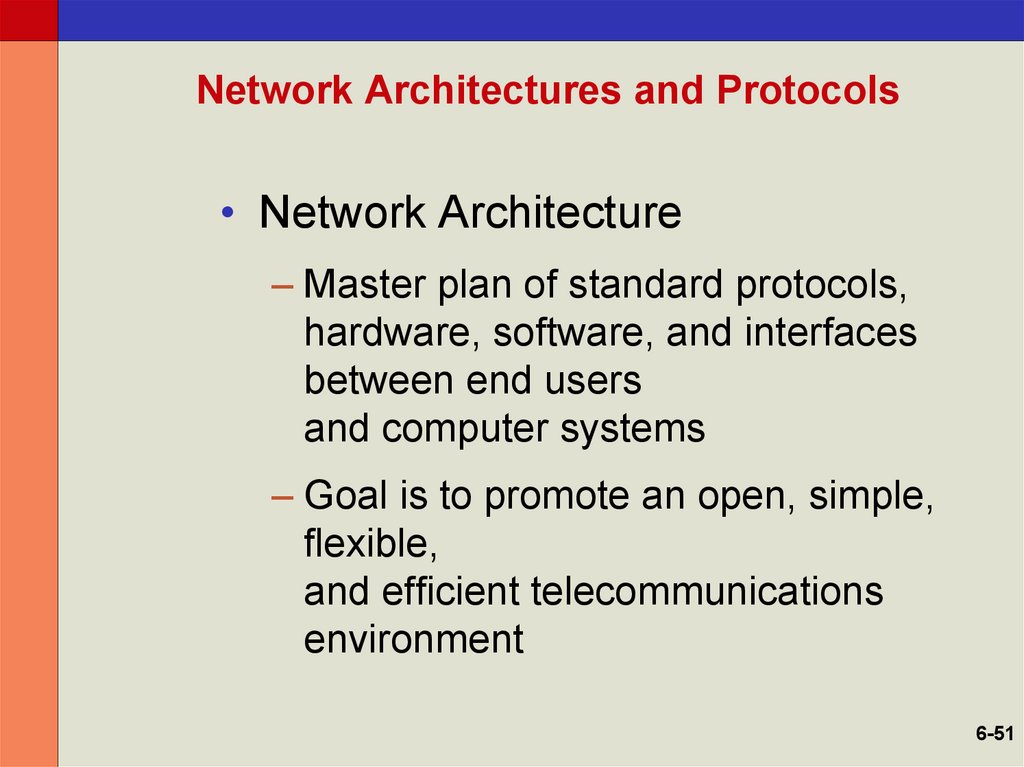
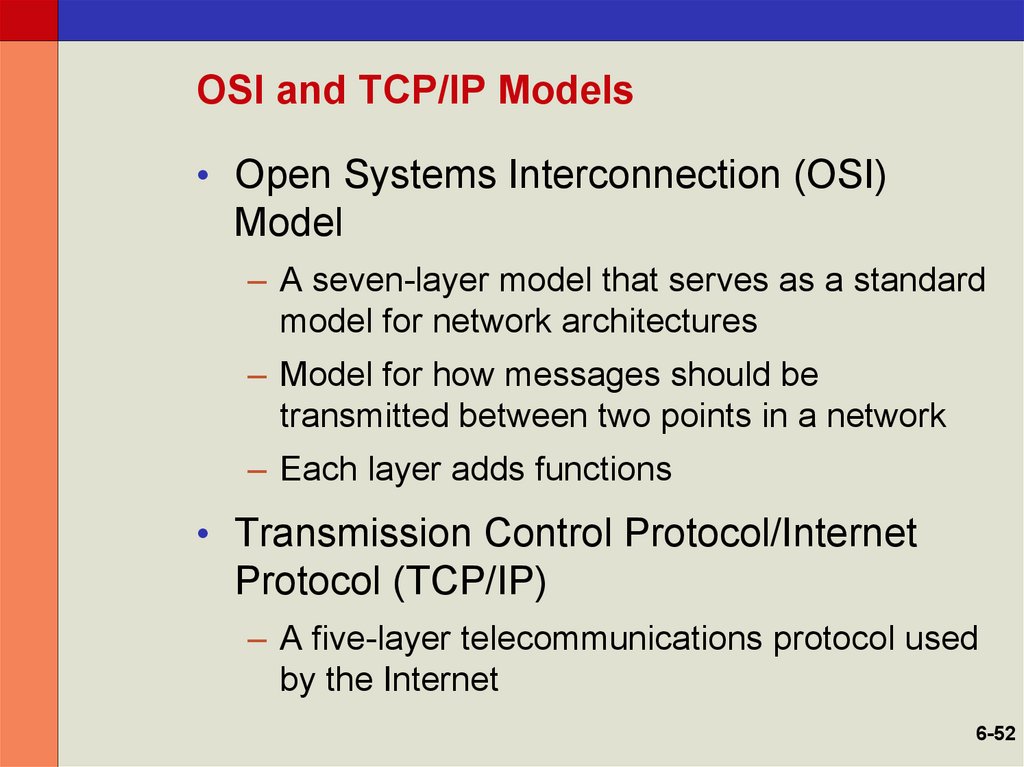
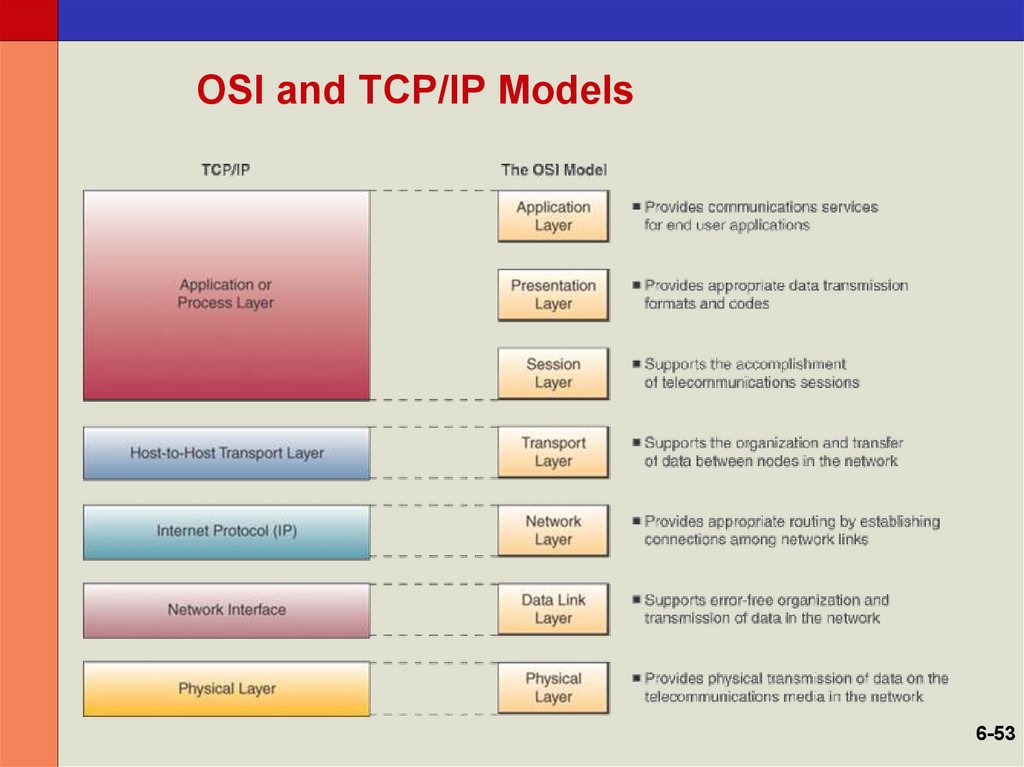
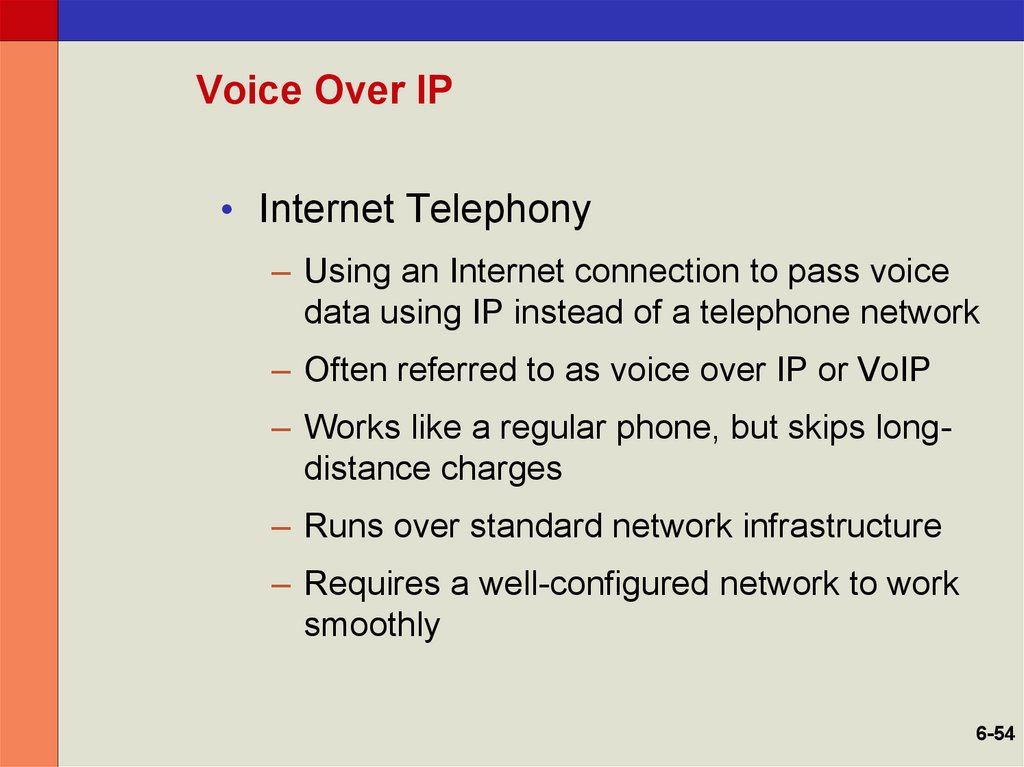

 Интернет
Интернет








